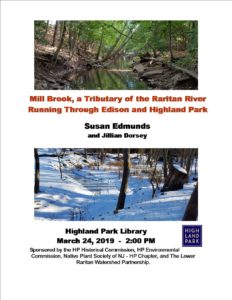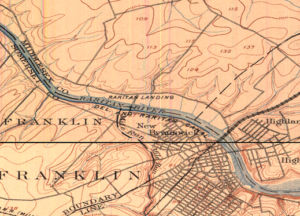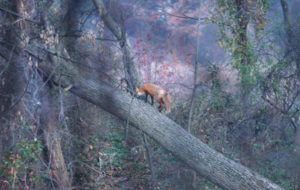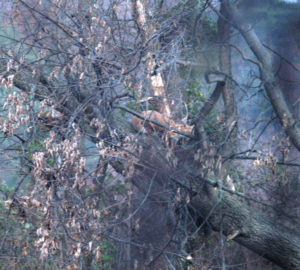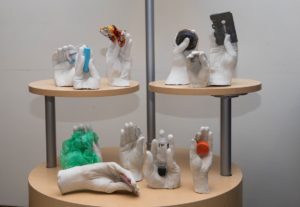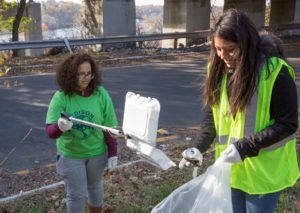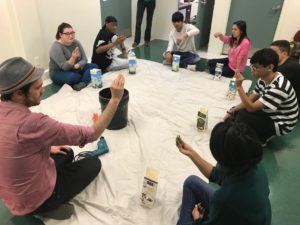Tag: Raritan River
Jimmy Rides Again!
Article and photos by Joe Mish
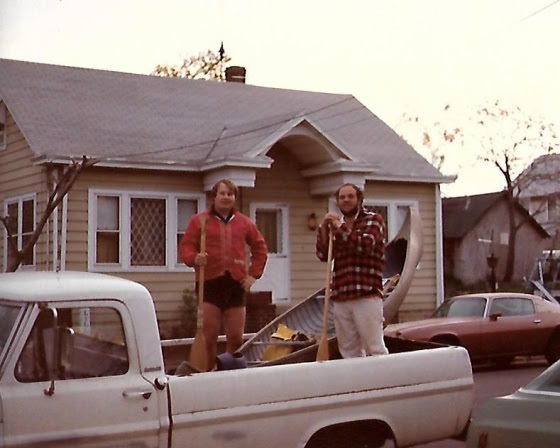
As elated as Lewis and Clark upon reaching the Colombia River, Jimmy and I proudly pose with our intrepid craft , “The Wild Turkey”, in the back of an old Ford Pickup
The eternal waters of the South Branch flow with memories and reflections, kept safe for those who have opened an account along its banks and written their story upon its waters.
I have a longstanding account, opened years ago, from which I make occasional withdrawals. The memories are recalled, polished with reflection and returned for safe keeping.
Hazy events, prompted by a scrap of paper that fell from one of my books, brought a canoe journey made decades before, into sharp focus. The lined, yellow paper, in my handwriting, was a record of time and places noted on a trip down the South Branch to the sea with my good friend Jim Serchio.
Jim worked across the hall from me in the pharmacology department at J&J. Intrigued by my stories of paddling solo to the mouth of the Raritan River; Jim recruited himself to join me on another run to the sea.
A hasty plan was hatched and a day chosen. We would launch from Main st in Clinton and paddle down to Keasbey. I would then walk to ‘Billy Vack’s Loop In’, an old iron workers bar located under the Parkway bridge, phone my brother-in-law, and get a ride in his pickup truck to my parent’s home, about three miles away.
The chosen canoe was my old canvas covered 1910 Old Town OTCA 16 named the “Wild Turkey”. Now stripped of canvas and covered with fiberglass, the hull was painted a flat, dead grass green and weighed in at about 85 pounds.
No cooler, just a couple of blue cushions and two guys in the canoe headed downstream. Jim was brilliant guy, studying biomedical engineering. I suppose it was his scientific inquisitiveness which finally prompted him, once we were underway, to ask, how long would the trip take. In my best carefully calculated estimation, I answered, “pretty much all day, we should be there before dark”.
As we passed under interstate 78, just after launching, I noted the time on my scrap of paper. Every time we passed a landmark, clock time was recorded.
Route 202 was reached at 9:23 am.
Looking over the sequence of shorthand notes, I now realize we had paddled under and over landmarks that are now gone or restored differently from their original form. Many of the metal bridges have been reconstructed over the years, their fieldstone supports now replicated by fieldstone veneer. I counted five bridges between Clinton and rt 31. The old dam we portaged below Dart’s mill is now essentially washed away. One bridge downstream of Neshanic station was not yet constructed. The scenery on the same trip today would be quite different.
Route 206 was reached at 1:09 pm
One entry made at 2:45 just before the second downstream pass under interstate 287 makes me smile; I wasn’t smiling then. I recorded the word ‘surgery’.
There was the wreckage of an old wooden bridge just before the last pass under I 287. It blocked our passage so we had to go up and over. As we set the heavy boat down on the rough planks, we did not see a huge spike that punctured the hull below the water line on the starboard side. The situation was looking grim as we were about to enter tide water on the last six hours of the trip. This meant navigating a running tide and staying clear of the main channel to avoid the large wakes churned up by tugboats and deep hulled pleasure craft.
Undaunted, we set the boat back in the water and began down river to see how bad the leak was. It was bad, real bad. How were we possibly going to finish. Pulling to shore, we looked around the debris, left by high tide, for a possible solution. Seeing a piece of yellow polypropylene rope, I had a flash of brilliance. As a kid I loved playing with fire, burning all sort of material including little plastic soldiers. The drops of melting plastic would quickly cool to form rock hard globs and even make a neat hissing sound as it dripped. On a hunch, I took the piece of rope, set it ablaze and dripped the plastic into the large hole in the hull. A perfect watertight fit and we were on our way.
At 4:30 we passed under rt 27, the low water encountered from 287 to Landing Lane Bridge road really slowed our progress. Now we had to deal with the wakes of large watercraft, which showed no mercy to two guys in a canoe. The resultant waves forced us to divert course, turn the bow into the wake and then re-correct to head downriver.
We passed the old drydock across from Crab Island at 6:15 and finally reached our destination under the New Jersey garden state parkway bridge, the former site of the Keasbey Outboard Motor Club, at 7:05pm.
While Jimmy entertained the bystanders, I headed up to Billy Vack’s to call my brother-in-law.
When I returned to the boat and Jimmy, someone asked where we put in. We were actually embarrassed to say, Clinton. We figured they wouldn’t believe us.
Our ride soon arrived and we could finally relax. We did it! Paddled from the NJ highlands to the Mouth of the Raritan river in about 12 hours in a 1910 Old Town canoe pressed into service for an epic journey to the sea.
Jimmy passed away a few years later from a medical procedure gone badly.
I still have the canoe and think fondly of the epic river journey shared with my good buddy Jim. The diary of times and places serves as a reference for memories and the ever changing river landscape.
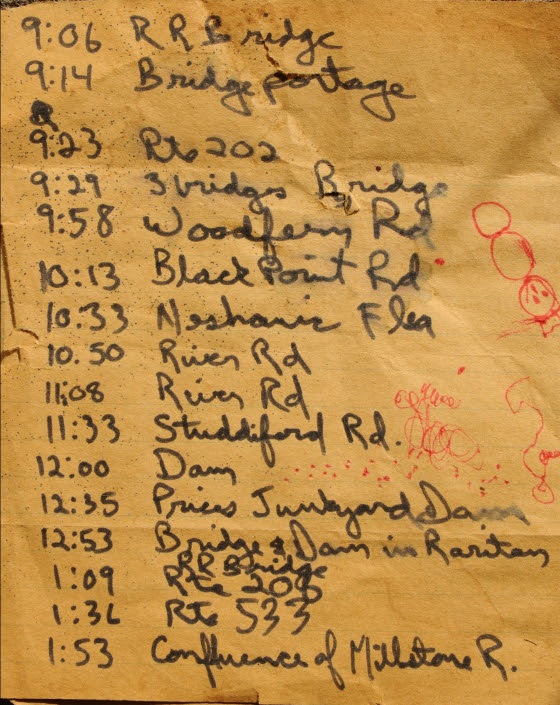
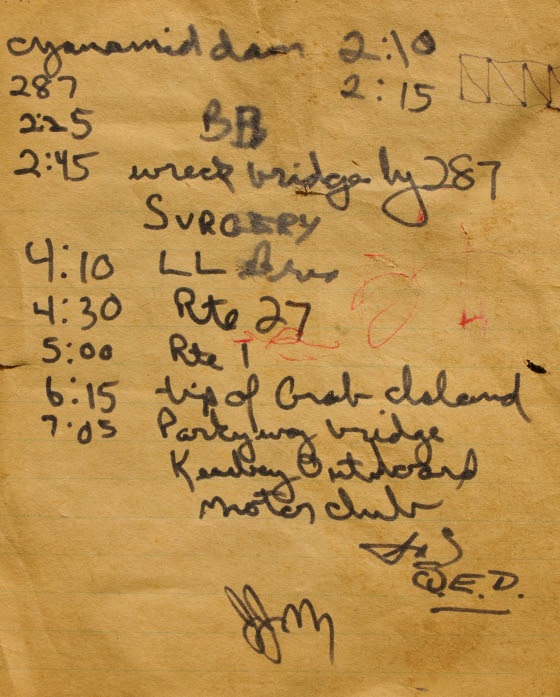
Two of three pages from the ship’s diary, documents the journey of “The Wild Turkey” and its crew, serves to sharpen the memory of a dash to the sea by two friends in a turn of the century canoe.
Author Joe Mish has been running wild in New Jersey since childhood when he found ways to escape his mother’s watchful eyes. He continues to trek the swamps, rivers and thickets seeking to share, with the residents and visitors, all of the state’s natural beauty hidden within full view. To read more of his writing and view more of his gorgeous photographs visit Winter Bear Rising, his wordpress blog. Joe’s series “Nature on the Raritan, Hidden in Plain View” runs monthly as part of the LRWP “Voices of the Watershed” series. Writing and photos used with permission from the author.
May 18 – Watershed Highlights: Duke Island Greenway walking tour
Join LRWP Board Member Professor David Tulloch as he leads our second “Watershed Highlights and Hidden Streams” walking tour of 2019!
Professor Tulloch will help us connect the old constructed landscapes of the canal at Duke Island County Park through a new greenway / bikeway that has been developed along the Raritan and crosses over into the Duke Farms properties. Many area residents are likely familiar with individual pieces of these recreation spaces. Fewer have made the walk to connect them all.
We expect to traverse 3 municipalities (and a named community that locals assume is a 4th municipality), and learn about the role that James Buchanan Duke played in shaping the hydrology of the area including creating multiple dams on the Raritan River to channel water to man-made lakes on the Duke Farms grounds.
Professor Tulloch says: “With the pump house and former dam, I think this will really be more about history than the hidden streams. But there are some interesting spots along the river where small streams contort themselves to cross the greenway.”
Join us from 9-11 AM on Saturday May 18.
Please park at the lot marked as the Raritan River Greenway on Old York Road between Woodmere St and Chestnut St, just barely inside Raritan Borough.
Registration required.
As we will not enter into Duke Park lands, dogs are allowed on this walking tour.
Rutgers Eco Preserve Walking Tour with Professor David Tulloch
For the LRWP’s inaugural “Watershed Highlights and Hidden Streams: Walks of the Watershed” Rutgers Professor David Tulloch will help us trace connections between Buell Brook and the Raritan River, starting at Johnson Park in Piscataway and traveling to Rutgers’ Eco Preserve.
Many people visit Rutgers’ Eco Preserve and don’t think of its connection to the Raritan River, even when they are only a few hundreds of yards away from it. This walk will look more at the connection and what it means.
We will travel from Johnson Park and Raritan Landing to the EcoPreserve, making the connection between the Raritan and this special campus feature.
Johnson Park/Raritan Landing – 1890s
Meet promptly at 3 PM in the Easternmost Parking lot at Johnson Park, near the Raritan (40.505693, -74.444186). Coming from Highland Park on Raritan Ave, go under the railroad trestle, make a left into Johnson park, and the meeting place is the 1st parking lot, on the right.
We will start with a gentler exploration of the riverbank and mouths of the Mill and Buell Brooks (and maybe more) and then head up into the Eco Preserve.
Wear comfortable walking shoes, clothing appropriate for the weather, and bring water. We expect the walk to run from 3-5 PM.
Help track stream salt levels with free “Salt Watch” kit
Did you all get caught in the snow squall yesterday? Leaving Rutgers campus at 3:15 PM I traveled a good half mile in near white out conditions on Route 1 North. Skies cleared at about 3:40 PM, just as I started on the Goodkind Bridge across the Raritan River. There was no precipitation at all as I traced the path of a salt spreader for the length of the span. In fact, the squall was the result of a very narrow band of precipitation and lasted a mere 25 minutes. It left just .02 of melted snow in our gauge.
Salt trucks are loaded with 12-15 tons of salt, and spread rates are about 400 pounds per lane mile of roadway. In the time I was behind that truck – the quarter mile or so across the bridge – approximately 100 pounds of salt was spread on one roadway lane. This was after the snow had stopped.
A new study released January 23, 2018 by University of Maryland researchers is the first to assess long-term changes in freshwater salinity and pH at the continental scale. Drawn from data recorded at 232 U.S. Geological Survey monitoring sites across the country over the past 50 years, the analysis shows significant increases in both salinization and alkalinization. The study results also suggest a close link between the two properties, with different salt compounds combining to do more damage than any one salt on its own.
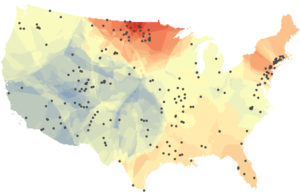
The results of this “freshwater salinization syndrome”? Infrastructure corrosion, contaminant mobilization, variations in coastal ocean acidification caused by increasingly alkaline river inputs, and significant impacts on ecosystem services such as safe drinking water, contaminant retention, and biodiversity.
Simply put, fish and bugs that live in the Raritan River and our freshwater streams can’t survive in extra salty water. And while almost all of us in the Lower Raritan depend on local streams for drinking water, water treatment plants are not equipped to filter out the extra salt, so it ends up in tap water and corrodes pipes.
Road salt is everywhere during winter months. It keeps us safe on roads and sidewalks, but it can also pose a threat to fish and wildlife as well as human health. Of course we want to keep our roadways safe. We also must ensure that any salt spreading be conducted utilizing best practices for sustainable use, which includes calibrating salt spreading in accordance with weather forecasts and minimizing the amount of salt spread over sensitive habitats.
There are things you can do to help us better understand the impacts of road salt on our local environments. The Cary Institute of Ecosystem Studies presents several best management practices in their new report: “Road Salt: The Problem, The Solution, and How to Get There.” One key recommendation is identifying areas for low or no salt application. That is, basically creating a buffer of “no salt zones” around any water body. This report also identifies substitutes for road salt, and their relative impact on our waterways.
And the Izaak Walton League is recruiting volunteers to help measure salt levels in area streams to gauge the extent of salt spreading impact. With the information they gather they will be able to develop a targeted and prioritized approach to reduction of salts in local and national waters. The Izaak Walton League requires a simple registration process, after which participants receive a free chloride test kit. The kit includes test strips and instructions to measure the chloride level in local streams, then report out findings in a national database.
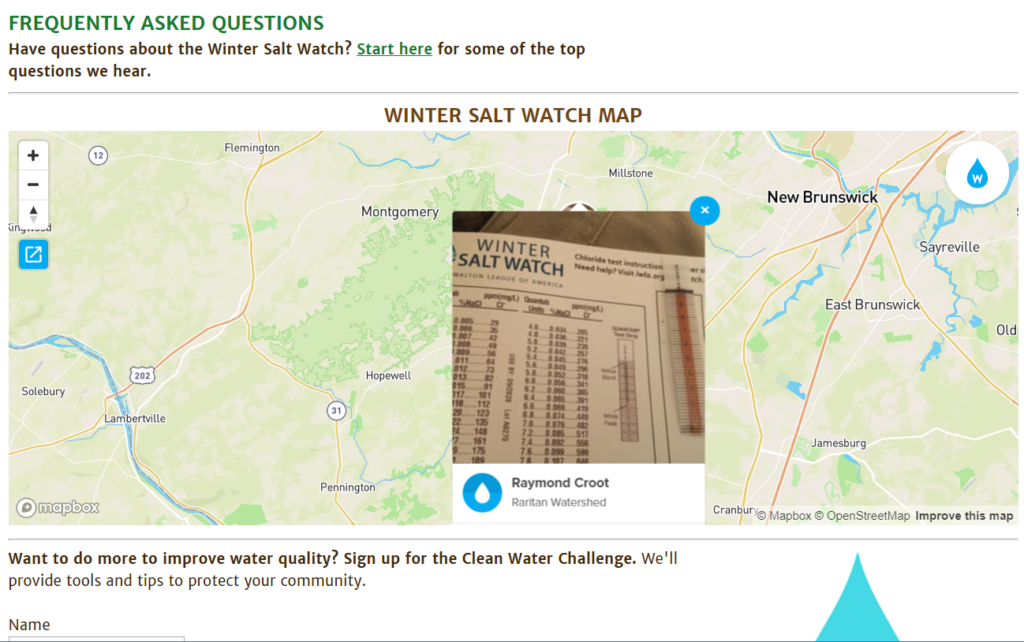
Dedicated Lower Raritan Watershed volunteer Raymond Croot is the first to submit “winter salt watch” data for a Lower Raritan stream.
November – the Far Side of Autumn
Article and photos by Joe Mish
Expect the unexpected when you look up into the leaf bare November woods. Here a red fox walks up a leaning tree to rest 30 feet high in the crotch of an adjoining tree. Red fox are not known to climb trees as are gray fox., but this fox channeled his inner gray fox to climb to dizzying heights.
November is the far side of autumn, a time when the colorful drapery of October is taken down to reveal the bare structure, upon which fluorescent orange leaves once hung.
The change in scenery is quite dramatic, as we pass through the colorful curtain that decorated the first full month of fall. I imagine standing behind a waterfall where colorful autumn leaves flow like cascading water to create a transparent wall of scarlet, orange and yellow. As I reach out to part the flowing colors, I step forward into November.
Linear brush strokes of gray and brown now dominate. Light and rain play with intensity of tone as the bare trees alternate between tans and gray to darker shades of brown and black. Rain saturates the branches to shift subtle earth tones to the bold end of their color spectrum.
The fading light of dusk and early light of dawn erase all color to turn trees into black silhouettes. The interlaced network of branches and solitary trees become one dimensional, as any perception of depth is lost against the stark contrast enhanced by the loss of daylight.
A dynamic lightshow in the sky then commences with a pale yellow glow as the sun departs over the horizon to melt into a pool of fiery orange. When the unmoving silhouetted trees are viewed against the ever changing celestial color spectrum, the still scene becomes a cinematic event.
Stars begin to appear well before the sun’s aura fades. Their sparkling silver brilliance is held against an even colored, dark blue night sky, making the perception of depth impossible to detect. Here, the background is static and the stars sparkle with energy. Just the opposite occurs where trees appear one dimensional and static, while the sky is alive with changing color.
All these theatric opposites combine in a single scene to create an inspiring, though brief preface, to the end of a November day.
A walk through the November woods cannot be more dramatically different than experienced a month before.
Strolling within the woods, beneath the canopy of trees, now without their leafy crowns, the lattice work of a branched arbor is apparent. Since late spring, a cloud of leaves dominated the view, banning shadows and sunlight.
A day time stroll on a sunny day or moonlit night, allows light to play with trunk and limb. Gnarled branches, which fought for their place in the sun, form grotesque figures that groan in the wind. The source of the sounds impossible to locate, lend a ghostly atmosphere even in the light of day. Shadows that begin to arise from a subterranean prison at the base of large trees, appear as immovable as the tree from which it escaped.
Turn away and back to find the shadow has imperceptibly moved, as it circles the tree to close the distance between you.
Walk along silently on the rain and color soaked carpet of October and let your imagination run wild. Animals and portions of human like figures, frozen in the transition of creation, hang like spare parts growing from trees.
While November is no one’s idea of autumn, given the cold, frost, barren landscape and introductory snowfalls, the month ends 21 days short of winter.
Author Joe Mish has been running wild in New Jersey since childhood when he found ways to escape his mother’s watchful eyes. He continues to trek the swamps, rivers and thickets seeking to share, with the residents and visitors, all of the state’s natural beauty hidden within full view. To read more of his writing and view more of his gorgeous photographs visit Winter Bear Rising, his wordpress blog. Joe’s series “Nature on the Raritan, Hidden in Plain View” runs monthly as part of the LRWP “Voices of the Watershed” series. Writing and photos used with permission from the author.
Jersey Water Works
The LRWP is pleased to be part of Jersey Water Works, a collaborative effort of many diverse organizations and individuals who embrace the common purpose of transforming New Jersey’s inadequate water infrastructure by investing in sustainable, cost-effective solutions that provide communities with clean water and waterways; healthier, safer neighborhoods; local jobs; flood and climate resilience; and economic growth. The LRWP is active on the Green Infrastructure subcommittee.
Jersey Water Works recently published Our Water Transformed: An Action Agenda for New Jersey’s Water Infrastructure – check it out! And plan to join Jersey Water Works for their annual conference on December 7 at the New Jersey Performing Arts Center in Newark!
Raritan River Festival 2019!
Stop by the LRWP table at the annual Raritan River Festival and Rubber Duck Race on Sunday, September 30! This is a free and family-friendly annual event celebrating our Raritan River.
Tons of fun activities are planned, including live music, environmental exhibitors, food vendors, activities for children, pony rides and a petting zoo, cardboard canoe races and the annual Rubber Duck Race.
The LRWP will be conducting water quality monitoring demos with the New Brunswick Environmental Commission and Rutgers Cooperative Extension, and hosting a special “hands-on” sculpture making workshop with our coLAB Arts partners. Don’t miss this annual summer festival in the City of New Brunswick!
What’s the Point?
Article and photos by Joe Mish
My South Branch office is made of kevlar and weighs 52#, well lit with natural light and leaves no trace. A perfect vehicle for discovering New Jersey’s natural treasure hidden in plain view.
Every once in a while, it is useful to check your back trail to validate your current course. For the last few years I have been attending the Rutgers sponsored, ‘Annual Sustainable Raritan River Conference’ and was introduced to the people and effort dedicated to improve the water and land that make up the Raritan River basin.
It was strange at first to hear someone else talk about my river. There was a moment of concern, a tinge of jealousy, that my ownership of the river was being usurped by strangers, some not even native to New Jersey. I soon realized I was among kindred spirits. It was like meeting long lost relatives….. whose company you sincerely enjoyed. Each member contributed a critical piece of the puzzle, whether a citizen, volunteer or a degreed scientist, each perspective complimented the other, and occasionally there was the discovery of a piece no one knew was missing. The symposium took the threads of individual effort and wove them into a whole cloth.
I was pleasantly surprised, the focus of the conference dovetailed perfectly into my goals and objectives. It also prompted me to revisit what I hope to accomplish with my images and words, given the current status of New Jersey’s relationship with its natural treasures.
Today New Jersey enjoys a natural inheritance that is the sum of the legacy left by generations of agrarian, industrial and residential development. Sacrificed in the name of progress, our natural and wild treasures are reputed to have been diminished to a vanishing point in the wake of the great human juggernaut. However, despite New Jersey’s recurring reputation as the most densely populated state in the union, wildlife is found to proliferate along its river corridors, highways, woods and fields. Much of this wildlife existed before the establishment of farms, whose disappearance falsely signals the surrender to unabated construction and development. The farms and cows are actually late-arriving interlopers, highly visible and used as a convenient but inaccurate measure of our intrinsic wild and natural resources. It is the presence or absence of cows that form the basis for politically subjective land use decisions.
Even the most ardent nature-oriented residents are often oblivious to the richness and distribution of this state’s natural treasures. Regional areas, reputed as nature destinations, add to obscure our natural treasures as their existence implies an absence of nature except where designated. Combine this with the perspective of the nature-neutral and nature-oblivious residents and it is understandable how the nature sterilized image of New Jersey arises from within and grows with distance to earn a national and global reputation as “the ghost of nature past”.
Against this background my photographic intentions range from historic documentation of ephemeral wild moments to portraiture revealing the energy and dignity of the creatures that covertly exist among us. What the camera misses the words capture, what the camera sees the words enhance.
The articles are a blend of literary flourish embedded with scientific information as much for entertainment as to arouse curiosity. I wish to create a gravitational pull of curiosity that draws the reader to seek deeper knowledge. Hopefully some youngster will be intrigued enough to pursue more detailed information and perhaps launch a career in science.
One reason New Jersey’s natural treasures remain hidden in plain view is because of prejudice and limited expectation. The best way to remedy this, is to change the lens through which our natural world is viewed. I do this by presenting stories and information from unique perspectives, along with images of wildlife most have never seen and many more don’t believe exist so close to home.
When I consider my place in the effort to restore the rivers, I see me operating on the interface between art and science. I walk that line to help transition attitudes and open eyes to a new reality fostered by creativity and imagination.
Rutgers fish camera at Island Weir Dam on the Raritan River is now online.
http://raritanfishcam.weebly.com
Author Joe Mish has been running wild in New Jersey since childhood when he found ways to escape his mother’s watchful eyes. He continues to trek the swamps, rivers and thickets seeking to share, with the residents and visitors, all of the state’s natural beauty hidden within full view. To read more of his writing and view more of his gorgeous photographs visit Winter Bear Rising, his wordpress blog. Joe’s series “Nature on the Raritan, Hidden in Plain View” runs monthly as part of the LRWP “Voices of the Watershed” series. Writing and photos used with permission from the author.
Middlesex County College Service: Watershed Sculpture Project
By Arianna Illa, Coordinator, Civic Engagement and Experiential Learning, Middlesex County College
The Watershed Sculpture Project: Middlesex County College
On Tuesday, November 21st of last year, students enrolled in Integrated Reading and Writing (ENG 096) at Middlesex County College (MCC) did something unusual for a typical college course. Rather than meeting in their classroom, they boarded a college van to travel to the Fox Road underpass, a stretch of road off the highway in Edison, NJ. This class excursion was the culminating event following a semester focused on reading, writing, discussing, and learning about environmental issues faced by local communities. In collaboration with the Lower Raritan Watershed Partnership (LRWP) and the Edison Environmental Commission, students planned and executed a community cleanup service project as part of the greater service learning initiative happening at the College.
Students Jessica Colon or Rahway (left) places trash in the bag held by Carolyn Muncibay of Old Bridge.
The cleanup involved spending 3 hours of class time bagging trash and recyclables along the underpass. The location of the cleanup was especially significant as it is uphill from the Raritan River. When it rains, trash and other contaminants travel downhill, further polluting the already vulnerable river. By the end of the cleanup, 17 bags of trash and recyclables, nine tires, a suitcase, car seats, as well as other large trash items were collected.
John Keller, Director of Education and Outreach of CoLAB Arts, assists students during the hand sculpture creation process.
During the cleanup, students selected one small trash item to bring back to campus. In collaboration with local arts advocacy organization CoLAB Arts, students created cement hand sculptures which are now on display in the MCC College Center in an exhibition titled The Watershed Sculpture Project: Middlesex County College. Each sculpture is of a student’s hand holding the trash item they saved from the cleanup.
The display demonstrates the large impact seemingly “small” amounts of littering can have on the environment as a whole, and likewise demonstrates the power of simple acts of stewardship (including stream clean-ups and socially engaged art) to effect positive environmental change. This work seeks to raise awareness of issues of environmental damage happening in the local community, and to prompts viewers to examine and reflect on their own relationship and interactions with the environment.
If your non-profit organization is interested in getting involved with service learning at MCC, please contact Arianna Illa, Coordinator of Civic Engagement and Experiential Learning, at ailla@middlesexcc.edu.

